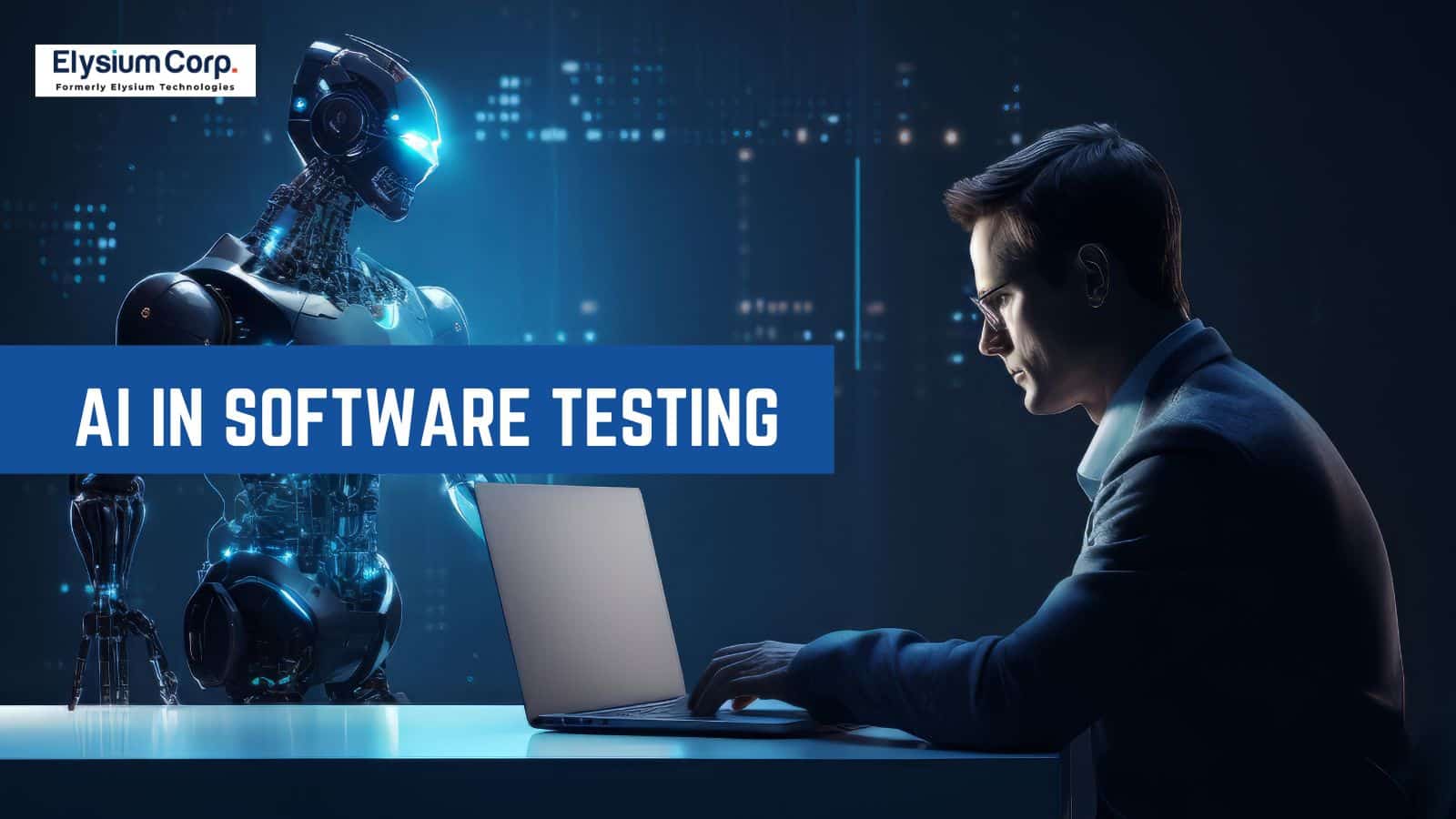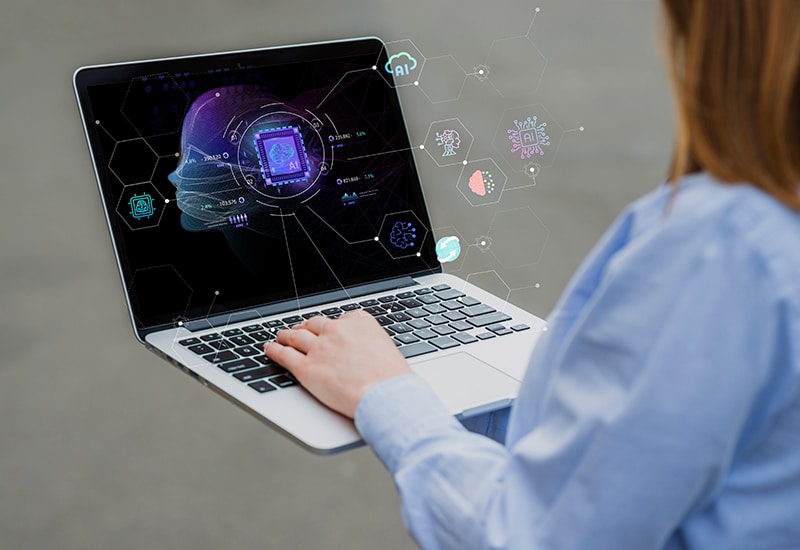Pioneering Performance: AI in Software Testing Excellence
“Partner with Elysium Technologies, a leader in AI in software testing, to revolutionize your quality assurance process. We design intelligent testing solutions powered by predictive analytics, self-healing automation, and machine learning. Our AI-driven QA strategies optimize performance, accelerate release cycles, and enhance software reliability. Connect with us today to experience the future of intelligent software testing.”
Years of Trusted Delivery
Data Accuracy Rate
Industry Verticals Served
AI in Software Testing
In the fast-paced world of software development, quality assurance plays a vital role in ensuring applications run flawlessly across devices, systems, and environments. As businesses accelerate their digital transformation, traditional testing methods often struggle to meet the demand for faster releases and higher reliability. This is where AI in software testing is making a profound impact.
Artificial Intelligence (AI) is not just another automation tool—it’s a transformative technology reshaping how testing is performed. By analyzing large data sets, learning from past defects, and predicting potential risks, AI development services enables smarter and faster decision-making throughout the testing lifecycle. From generating test cases automatically to identifying hidden defects, AI in software testing helps QA teams achieve accuracy, speed, and scalability that were once impossible through manual processes.
The adoption of AI in software testing signifies a major leap toward intelligent automation. It empowers teams to reduce repetitive tasks, enhance test coverage, and deliver flawless user experiences. In 2025 and beyond, AI-driven testing will no longer be optional—it will become a core pillar of software quality and business success.
Evolution of Software Testing: Traditional vs. AI
For decades, software testing has evolved alongside the rapid advancements in development methodologies. From manual testing to automation frameworks, every phase has aimed to improve efficiency, accuracy, and reliability. However, as applications grow in complexity and release cycles shorten, traditional methods are proving insufficient. This evolution has led to the rise of AI in software testing, redefining how QA teams ensure product quality.
Traditional Testing Methods
In traditional testing, human testers design, execute, and validate test cases based on predefined requirements. These processes are highly dependent on experience, intuition, and manual verification. Although this approach offers control and deep insight, it is time-consuming, repetitive, and prone to human error. Maintaining and updating test cases becomes a challenge when applications undergo frequent changes, leading to longer release cycles.
Even with the introduction of automation tools like Selenium and QTP, traditional automation scripts still require manual intervention. They are rigid—any minor UI update or code modification can break the automation flow. As a result, testers spend more time fixing scripts than running tests. This creates a bottleneck in agile and DevOps environments, where continuous testing is essential.
The Shift Toward AI-Driven Testing
The limitations of conventional methods have paved the way for AI in software testing, which integrates machine learning, predictive analytics, and automation intelligence. Unlike traditional systems, AI-driven testing tools continuously learn from historical data, adapt to application changes, and enhance themselves over time.
For instance, AI algorithms can automatically detect patterns in failed test cases, predict potential bugs, and prioritize testing based on risk levels. By using techniques like natural language processing (NLP), AI can even convert plain-language requirements into executable test scripts—reducing the dependency on manual coding.
A New Era of Intelligent QA
The shift from manual to AI-driven testing represents more than just a technological upgrade—it’s a cultural transformation in QA. With AI in software testing, teams can transition from reactive defect detection to proactive quality prediction. Testers are now strategic partners in innovation rather than just executors of test cases.
By 2025, the integration of AI technologies into testing workflows has become standard practice for leading enterprises. This evolution continues to push boundaries, ensuring that quality, speed, and user satisfaction coexist in the digital era.
Key Technologies Powering AI Testing
The power of AI in software testing lies in the advanced technologies that drive automation, intelligence, and adaptability. These technologies work together to create smarter, faster, and more reliable testing environments. Understanding these core enablers helps QA teams grasp how AI is transforming traditional workflows into intelligent ecosystems.
1. Machine Learning (ML)
Machine Learning forms the foundation of AI in software testing. It allows systems to analyze historical data, identify patterns, and make predictions. In testing, ML algorithms can learn from past test results to predict which modules are most likely to fail in future releases. This predictive defect analytics reduces redundant tests and focuses efforts where the risk is highest. Over time, ML improves accuracy, optimizes resource allocation, and ensures faster feedback cycles.
2. Natural Language Processing (NLP)
NLP enables machines to understand human language. In the context of testing, it bridges the gap between technical test cases and business requirements. NLP-driven tools can convert plain English instructions into executable test scripts automatically. For example, when a tester writes “verify login button visibility,” the tool interprets and executes the corresponding automation step. This technology makes AI in software testing accessible even to non-programmers through codeless test creation.
3. Computer Vision
Computer Vision allows AI systems to visually analyze user interfaces just as humans do. It helps detect visual bugs, alignment issues, and design inconsistencies that traditional automation frameworks often miss. Computer Vision ensures that applications deliver consistent UI experiences across different devices and browsers—essential for modern web and mobile testing.
4. Predictive Analytics
Predictive analytics uses AI algorithms to forecast where bugs are likely to occur based on code changes, past failures, and user behavior data. This helps QA teams prioritize high-risk areas and allocate resources efficiently. By integrating predictive analytics into AI in software testing, organizations move from reactive testing (finding defects) to proactive quality assurance (preventing them).
5. Self-Healing Mechanisms
One of the most revolutionary features of AI-driven tools is the ability to self-heal. When an application changes—such as an element’s ID or layout—the automation script automatically identifies and updates the locator without human intervention. This drastically reduces test maintenance time and ensures stability in continuous testing environments.
6. Generative AI
Generative AI is the latest advancement in AI in software testing, capable of creating new test cases, test data, and even simulated environments autonomously. Using large language models (LLMs), generative AI can design complex testing scenarios based on minimal inputs. It ensures comprehensive test coverage and uncovers edge cases that traditional approaches might overlook.
7. Robotic Process Automation (RPA)
RPA enhances repetitive test tasks by mimicking human actions across systems. Combined with AI, RPA becomes more intelligent—able to make decisions, handle exceptions, and integrate seamlessly with CI/CD pipelines. This fusion of RPA and AI in software testing enables hyperautomation, where every step from test creation to execution is streamlined.
Core Benefits of Integrating AI
The integration of AI in software testing is not just a technological enhancement—it’s a strategic transformation that reshapes how organizations deliver high-quality software faster and more efficiently. By embedding AI-driven tools into the QA process, businesses can reduce human error, improve precision, and accelerate time-to-market. Below are the key benefits that make AI an indispensable part of modern software testing.
1. Improved Accuracy and Defect Detection
One of the most powerful advantages of AI in software testing is its ability to detect defects with remarkable precision. AI algorithms can scan large volumes of test data, analyze logs, and identify subtle anomalies that manual or rule-based systems might overlook. This leads to earlier detection of defects, minimizing production issues and ensuring stable, reliable software releases.
Machine learning-based models learn from historical test results to continuously enhance accuracy, making each subsequent test cycle smarter than the previous one.
2. Accelerated Test Execution
Traditional testing often struggles with long execution times, especially for regression and end-to-end tests. AI-enabled automation eliminates this bottleneck by enabling parallel execution across different platforms and environments. Intelligent prioritization ensures that the most critical tests are executed first, significantly reducing overall testing time.
As a result, release cycles shorten, and QA teams can deliver frequent updates without compromising quality—an essential feature in agile and DevOps workflows.
3. Predictive Defect Analytics
Predictive analytics is a cornerstone of AI in software testing. Using data-driven insights, AI predicts which parts of the application are most likely to fail in upcoming builds. This allows teams to focus their testing efforts strategically rather than relying on random or exhaustive test execution. Predictive defect analytics enhances test efficiency, conserves resources, and prevents costly production failures.
4. Self-Healing Test Scripts
A common challenge in automation is maintaining scripts when application elements change. AI solves this problem through self-healing test automation—a mechanism that automatically updates or corrects test scripts when locators or UI structures are modified. This drastically reduces maintenance overhead and ensures stable test performance even during rapid development cycles.
5. Enhanced Test Coverage
By combining machine learning, generative AI, and data analytics, testers can achieve broader and deeper test coverage. AI tools can automatically generate test cases based on application behavior, user flows, and code structure. This not only improves coverage but also helps uncover edge cases that might otherwise go unnoticed.
With AI in software testing, QA teams can ensure every component, function, and integration point is thoroughly validated.
6. Real-Time Risk Assessment
AI introduces real-time intelligence into quality assurance. During test execution, AI systems continuously monitor logs, performance metrics, and system responses to assess risks dynamically. When an anomaly or potential defect is detected, it immediately alerts the QA team with detailed insights. This real-time risk assessment ensures faster issue resolution and higher system stability.
7. Cost and Resource Optimization
Implementing AI in software testing significantly reduces manual effort, repetitive work, and script maintenance. Automation powered by AI lowers the cost of testing by minimizing human intervention while improving accuracy and speed. It also allows organizations to reallocate skilled QA professionals to more analytical, creative, and strategic roles—maximizing resource value.
8. Continuous Testing and Integration
AI integrates seamlessly into continuous testing pipelines, enabling end-to-end automation. It ensures that every new build is automatically validated against previous versions, providing instant feedback to developers. Continuous integration and delivery (CI/CD) environments benefit greatly from this approach, as AI in software testing maintains consistent quality without slowing down development.
9. Intelligent Test Prioritization
AI-driven systems analyze the codebase, defect history, and user analytics to prioritize which tests should run first. This ensures that high-risk or frequently changing components are tested before others. Intelligent test prioritization saves time, prevents redundant executions, and improves test effectiveness.
10. Data-Driven Decision Making
Perhaps the most transformative advantage of AI in software testing is its ability to generate actionable insights from vast test data. By leveraging analytics dashboards, QA leads and product managers can make data-backed decisions on release readiness, quality trends, and performance stability. This aligns testing outcomes directly with business goals.
AI Applications in Modern Testing Workflows
The true potential of AI in software testing is realized through its wide range of applications across the entire QA lifecycle. From test creation and execution to analysis and maintenance, AI technologies streamline processes, improve accuracy, and enable teams to deliver software faster than ever. Let’s explore the major ways AI is reshaping modern testing workflows.
1. Intelligent Test Case Generation
AI-powered systems analyze application requirements, design documents, and user behavior data to automatically generate test cases. Unlike traditional methods that rely on manual scripting, these intelligent models learn from historical projects to identify which areas need more focus.
This approach not only reduces human effort but also ensures that tests align closely with business goals. By adopting AI in software testing, QA teams can accelerate planning and improve overall test coverage without missing critical functionalities.
2. Automated Test Data Generation
Test data creation is one of the most time-consuming steps in QA. AI simplifies this by generating realistic, diverse, and compliant data sets that mimic real-world user interactions. Using pattern recognition and data modeling, AI tools can even fill in missing data points or generate edge-case scenarios. This ensures that testing covers all possible outcomes—both common and rare.
3. Self-Healing Test Automation
One of the standout applications of AI in software testing is self-healing automation. When UI elements or application logic changes, traditional scripts tend to break. AI solves this by automatically identifying new locators, adjusting scripts, and continuing test execution without manual intervention. This ability to self-correct makes automated testing far more stable and cost-effective.
4. Predictive Defect Analytics
Predictive defect analytics enables QA teams to foresee potential failure points before they occur. By analyzing previous test results, code commits, and user logs, AI models predict areas with the highest likelihood of defects. This proactive approach helps teams prioritize high-risk areas and prevent critical issues from reaching production.
5. Visual Testing with Computer Vision
Modern applications demand pixel-perfect interfaces across devices. AI-driven visual testing uses computer vision algorithms to detect UI mismatches, alignment errors, and color inconsistencies that are invisible to traditional tools. With this capability, AI in software testing ensures visual consistency and enhances the overall user experience.
6. Continuous Testing in DevOps Pipelines
AI is a game-changer in continuous integration and delivery (CI/CD) pipelines. It ensures that every new code change is automatically tested and validated in real time. AI-based monitoring tools analyze test outcomes, identify bottlenecks, and optimize execution speed. This continuous testing capability ensures that teams can deliver updates faster without sacrificing quality.
7. Intelligent Test Maintenance
Over time, test suites tend to grow large and complex, leading to redundancy and inefficiency. AI tools automatically analyze test results to identify obsolete or duplicate cases, optimizing the overall suite. This “test suite optimization” ensures faster execution and more meaningful coverage—keeping QA agile and efficient.
8. Root Cause Analysis and Debugging
Debugging has traditionally required manual tracing of logs and dependencies. With AI in software testing, tools can automatically pinpoint the root cause of failures by analyzing system logs, performance data, and dependencies. AI’s ability to correlate multiple sources of information significantly reduces troubleshooting time and accelerates defect resolution.
9. Edge Case and Exploratory Testing
AI’s capacity to simulate real-world conditions enables effective exploratory testing. By analyzing user behavior data and environmental variables, AI identifies edge cases that humans may not predict. This helps uncover hidden bugs that could affect user experience or security, ensuring more robust and reliable applications.
10. Performance and Load Testing
AI-enhanced performance testing uses machine learning algorithms to simulate user loads, detect performance bottlenecks, and predict system behavior under stress. AI models adapt test parameters dynamically, providing insights into scalability and reliability. This predictive approach to performance testing helps teams plan capacity and improve infrastructure readiness.
11. Real-Time Monitoring and Risk Assessment
Modern QA environments demand instant feedback. AI systems continuously monitor test executions, user sessions, and production logs to detect risks in real time. When anomalies are found, AI automatically flags them, prioritizes based on severity, and suggests corrective actions. This proactive alerting reduces downtime and prevents end-user impact.
12. Automated Regression Testing
Regression testing is one of the most time-intensive tasks in QA. AI in software testing simplifies this by identifying which tests are most relevant to new code changes. It eliminates redundant cases and runs only the necessary ones, drastically reducing execution time while maintaining comprehensive coverage. AI ensures smarter, faster, and more efficient regression cycles.
13. Intelligent Reporting and Insights
Beyond execution, AI also improves how test results are analyzed and reported. Using analytics dashboards, it identifies trends, recurring failures, and test effectiveness metrics. These insights empower QA leads to make data-driven decisions, enhance performance, and improve release quality over time.
Popular AI Testing Tools of 2025
As the adoption of AI in software testing continues to expand, a new generation of intelligent testing tools has emerged to automate, analyze, and optimize every stage of quality assurance. These tools combine the power of artificial intelligence, machine learning, and predictive analytics to help QA teams achieve higher speed, accuracy, and scalability. Below are some of the most popular and effective AI-powered testing tools leading the industry in 2025.
1. Testim
Testim uses machine learning to create, execute, and maintain automated test cases. Its self-healing feature automatically updates locators when the application UI changes, ensuring that tests remain stable over time. Testim’s AI capabilities help reduce maintenance effort and improve test reliability, making it ideal for agile teams practicing continuous integration and deployment.
2. Applitools
Applitools is one of the most recognized tools in AI in software testing due to its Visual AI technology. It uses advanced computer vision algorithms to perform visual regression testing and detect even the slightest UI differences across browsers, devices, and screen sizes. Applitools Eyes ensures flawless user experiences through pixel-perfect validation.
3. Mabl
Mabl integrates machine learning directly into automated testing workflows. It offers intelligent test creation, execution, and analysis with a simple, code-free interface. Mabl automatically adapts tests to UI updates and provides detailed performance insights. It’s widely used in CI/CD pipelines to maintain continuous testing across multiple environments.
4. Functionize
Functionize combines natural language processing (NLP) and machine learning to simplify test creation. Testers can write test steps in plain English, and the platform converts them into executable scripts. Its intelligent cloud architecture enables parallel execution and automatic result analysis—making AI in software testing accessible to non-technical users.
5. TestCraft
TestCraft offers codeless Selenium-based test automation enhanced by AI. It provides continuous monitoring, self-healing capabilities, and visual flow modeling. Its AI-driven optimization minimizes test maintenance and allows quick adjustments to UI or logic changes without rewriting scripts.
6. Parasoft SOAtest
Parasoft integrates AI and analytics to test APIs, microservices, and complex integrations. It automatically identifies risk areas and recommends test cases to improve coverage. The platform’s ability to analyze defect patterns helps predict and prevent issues in upcoming releases.
7. Sauce Labs (Visual and Functional Testing)
Sauce Labs has expanded its capabilities by incorporating AI in software testing to offer visual regression testing, analytics, and smart test execution. Its machine learning models identify flaky tests, prioritize them based on risk, and provide insights to enhance test reliability across cloud-based environments.
8. TestSigma
TestSigma leverages NLP and AI to enable codeless test automation. Users can create automated tests in plain English, while AI handles maintenance, parallel execution, and optimization. It integrates seamlessly with CI/CD pipelines, supporting continuous and agile testing models.
9. Tricentis Tosca
Tricentis Tosca uses AI-driven model-based automation to test across web, mobile, and enterprise applications. It provides smart impact analysis to determine which tests are affected by code changes, saving significant time during regression testing. Tosca’s AI engine ensures consistent test accuracy throughout the lifecycle.
10. Katalon TestOps
Katalon’s TestOps platform integrates analytics and machine learning to provide actionable insights into test performance, coverage, and execution trends. It automates repetitive tasks, improves defect tracking, and enhances decision-making with AI-generated reports.
11. Test.ai
Test.ai brings AI in software testing to mobile and web applications through intelligent test bots. These bots learn user behavior patterns and execute functional and exploratory tests autonomously. They can recognize UI components, simulate real-world interactions, and validate outcomes—mimicking how humans use software.
12. LambdaTest Smart Testing
LambdaTest integrates AI for intelligent test orchestration and smart parallel execution. It uses predictive analytics to identify risky builds, prioritize tests, and detect failures early. This AI-driven efficiency ensures faster release cycles and high-quality output.
13. ACCELQ
ACCELQ offers AI-powered codeless test automation for API and UI testing. Its self-healing and impact analysis features minimize maintenance while ensuring adaptability. The tool supports predictive planning and test optimization, making it a favorite for enterprise-level automation strategies.
14. TestRigor
TestRigor uses natural language input and AI to generate automated test scripts. It continuously learns from test outcomes and adjusts itself for higher accuracy. The platform reduces human dependency and accelerates the transition toward fully autonomous testing systems.
15. Eggplant (by Keysight)
Eggplant uses AI and image-based recognition to perform end-to-end functional testing. It predicts defects, assesses user experience, and validates performance across multiple environments. Its intelligent algorithms make AI in software testing more efficient, especially for enterprise-grade applications.
Case Studies: Real-World Impact of AI
The adoption of AI in software testing isn’t just theoretical; it has already transformed how global enterprises deliver reliable and secure digital experiences. Across multiple industries, organizations are leveraging intelligent automation, predictive analytics, and machine learning algorithms to enhance their testing capabilities.
1. Banking and Financial Services
A leading global bank integrated AI in software testing to improve the accuracy of its mobile app validation. By implementing machine learning-driven test suites, the bank reduced regression testing time by 65%. AI tools analyzed historical defects to predict high-risk areas, allowing the QA team to focus their efforts more strategically. As a result, the bank’s app updates reached production faster and with fewer critical errors.
2. E-Commerce and Retail
An international e-commerce company utilized AI-powered test automation to handle complex workflows involving millions of user interactions. AI algorithms automatically detected UI changes and adapted existing test scripts—removing the need for manual rework. This self-healing capability improved test resilience and maintained consistent quality even as the platform underwent frequent design updates.
3. Healthcare Technology
In healthcare, where accuracy is paramount, a medical software company deployed AI in software testing to validate patient data management systems. AI-based anomaly detection identified data discrepancies and compliance issues early in the testing cycle. This proactive testing approach ensured regulatory compliance while improving patient safety and system reliability.
4. Telecommunications
A telecom provider adopted AI-driven test case generation to streamline its complex network software updates. By learning from system logs and usage data, AI created optimized test cases that covered real-world network conditions. This not only improved efficiency but also enhanced overall performance and reliability in live environments.
These case studies illustrate that AI in software testing has tangible business benefits — faster releases, lower costs, fewer bugs, and improved user satisfaction. Organizations that have embraced AI-driven testing are already witnessing measurable returns on investment through increased productivity and reduced time-to-market.
Challenges and Considerations
While AI in software testing delivers immense potential, its implementation also brings a set of challenges that organizations must carefully navigate. Understanding these hurdles is crucial for successful adoption and long-term results.
1. Data Quality and Availability
AI systems thrive on data — but the accuracy of AI in software testing depends heavily on the quality of training data. Inconsistent, incomplete, or biased datasets can lead to incorrect predictions or overlooked defects. To overcome this, QA teams must collect diverse, high-quality datasets that represent real-world user behavior.
2. Initial Implementation Costs
Introducing AI in software testing often requires investment in specialized tools, infrastructure, and skilled professionals. Although the long-term savings are substantial, organizations may face budget constraints during the initial setup phase. A clear ROI-driven strategy can help justify and manage this investment.
3. Skill Gap in QA Teams
Traditional QA engineers may lack the technical expertise required to handle AI-driven systems. Understanding algorithms, data patterns, and automation tools is essential for effective usage. Continuous upskilling and collaboration between QA and data science teams are vital for bridging this skill gap.
4. Integration with Existing Systems
Many legacy systems are not designed to integrate with AI-based tools. Organizations implementing AI in software testing must ensure compatibility between old frameworks and modern AI solutions. This often involves upgrading systems or using APIs to facilitate seamless communication.
5. Ethical and Bias Concerns
AI algorithms can sometimes make decisions that lack transparency. If the training data contains bias, AI systems may reproduce or amplify it. In the context of software testing, this could mean overlooking certain types of user scenarios. Therefore, maintaining ethical AI in QA is essential to ensure fairness, transparency, and accountability.
6. Dependence on Automation
While automation enhances efficiency, overreliance on AI could lead to reduced human oversight. Manual testing is still necessary for exploratory, usability, and emotional aspects of user experience that machines can’t yet understand fully. A balanced approach combining human insight and AI in software testing ensures the best results.
Overcoming these challenges requires a well-planned strategy — one that aligns technology adoption with business objectives, governance standards, and continuous improvement. When managed wisely, these challenges transform into opportunities for innovation and excellence.
Ethical AI and Quality Assurance
As organizations increasingly adopt AI in software testing, the conversation around ethics and transparency becomes more critical. Artificial Intelligence can make autonomous decisions — but without ethical guidelines, these decisions might lead to unintended consequences such as bias, data misuse, or inaccurate reporting. Therefore, integrating ethical AI in QA is not just a technical requirement but a moral and operational responsibility.
1. Transparency and Explainability
One of the biggest challenges in implementing AI in software testing is understanding how AI models make their decisions. QA teams must ensure that AI-driven tools are explainable — meaning testers can trace and understand the reasoning behind a defect prediction, risk score, or test case prioritization. This transparency helps maintain accountability and trust within the organization.
2. Data Privacy and Security
AI systems often process massive volumes of test and production data, which may include sensitive information. Ensuring data privacy is crucial when using AI in software testing. Companies must adhere to data protection regulations like GDPR and use anonymization techniques to safeguard user identities during testing.
3. Bias and Fairness
If AI is trained on biased datasets, it might favor certain test scenarios while ignoring others. This can compromise the completeness of testing. To maintain fairness, QA teams should use diverse and balanced datasets and perform regular audits to identify bias in AI outputs. Ethical AI ensures that testing remains inclusive, accurate, and equitable for all user groups.
4. Human Oversight
Despite its intelligence, AI should not operate in isolation. Human testers play a vital role in validating AI-generated results, providing context, and making ethical decisions when anomalies occur. Maintaining human oversight ensures that AI in software testing complements, rather than replaces, human judgment.
5. Accountability and Governance
To ensure responsible use, organizations must establish clear governance models for AI in software testing. This includes defining accountability structures, documenting AI-driven decisions, and setting ethical guidelines that align with company values. Continuous monitoring and reporting help sustain ethical standards over time.
In short, ethical AI isn’t just about compliance — it’s about building trust. When QA teams uphold fairness, transparency, and accountability, they not only enhance the reliability of AI systems but also strengthen user confidence in the software being delivered.
How to Adopt AI in Testing: Step-by-Step Guide
Implementing AI in software testing requires more than simply installing a new tool. It’s a structured transformation that blends technology, process, and people. To ensure success, organizations should follow a clear roadmap that enables seamless integration of AI into existing QA workflows.
Step 1: Assess Current Testing Maturity
Before deploying AI in software testing, analyze your current testing environment — tools, coverage, automation rate, and pain points. Identify repetitive manual tasks and high-defect areas that would benefit most from AI-driven insights. This assessment helps prioritize use cases and ensures strategic alignment with business goals.
Step 2: Define Objectives and Success Metrics
AI adoption should have measurable goals — such as reducing testing time, improving defect detection accuracy, or increasing test coverage. Establish key performance indicators (KPIs) like mean time to detect defects, automation success rate, and release cycle speed. Defining these metrics ensures that AI in software testing delivers tangible business value.
Step 3: Choose the Right Tools and Frameworks
Select tools that align with your tech stack, testing type, and scalability needs. Popular options include AI-powered test automation platforms, predictive analytics engines, and self-healing script frameworks. The chosen tools should integrate smoothly with CI/CD pipelines and support DevOps practices for continuous testing.
Step 4: Prepare and Train Data
AI models rely on historical data to make predictions. Gather logs, defect reports, performance metrics, and previous test cases. Clean and label this data to ensure accuracy. A well-prepared dataset enables the AI system to learn patterns, identify defects, and optimize test case selection effectively.
Step 5: Start with a Pilot Project
Implement AI in software testing in a controlled environment before scaling. A pilot project helps validate performance, uncover technical challenges, and measure ROI. Choose a project with moderate complexity to test the AI tool’s adaptability and decision-making capabilities.
Step 6: Integrate with Existing Workflows
AI should enhance—not disrupt—your existing processes. Integrate AI tools with your current test management and automation systems. Ensure that communication between teams remains transparent so testers can interpret and validate AI-generated insights.
Step 7: Upskill QA Teams
Empower QA engineers through AI-focused training programs. Educate them on machine learning basics, data interpretation, and tool operation. When testers understand how AI algorithms function, they can collaborate more effectively with the technology, ensuring optimal outcomes.
Step 8: Continuously Monitor and Improve
AI systems evolve over time. Continuously track performance metrics, retrain models with fresh data, and fine-tune algorithms to maintain accuracy. Regular monitoring helps sustain the efficiency and reliability of AI in software testing across projects.
By following these steps, organizations can successfully transition from traditional QA to intelligent testing ecosystems. With careful planning and gradual implementation, AI in software testing becomes a long-term strategic asset that enhances speed, accuracy, and business confidence.
Future Trends: What’s Next for AI Testing
The landscape of AI in software testing is evolving rapidly, and the coming years promise even more groundbreaking advancements. As businesses continue to demand faster, smarter, and more reliable software delivery, AI-driven testing will expand into new dimensions, powered by automation, analytics, and innovation.
1. Hyperautomation and Continuous Intelligence
In 2025 and beyond, hyperautomation will dominate QA ecosystems. Combining AI in software testing with robotic process automation (RPA), analytics, and DevOps integration will enable continuous testing pipelines. This approach ensures real-time defect detection and instant feedback loops — shortening release cycles while improving product stability.
2. Self-Healing Test Suites
Self-healing automation is set to become a standard capability in future testing frameworks. AI will automatically detect script failures caused by UI or functionality changes and repair them without human intervention. This advancement will drastically reduce maintenance efforts and keep testing consistent even during rapid software updates.
3. Generative AI for Test Case Creation
Generative AI models can analyze application behavior and automatically generate new test cases, data sets, and even test scripts. As AI in software testing becomes more sophisticated, these generative systems will help QA teams focus on higher-level strategy while AI handles repetitive and data-driven tasks.
4. Predictive and Prescriptive Analytics
The future of testing lies in predictive intelligence. AI will not only detect defects but also predict where failures are most likely to occur — and even prescribe preventive measures. Predictive defect analytics will minimize post-release issues and improve overall software resilience.
5. Integration with Low-Code and No-Code Platforms
The rise of low-code and no-code platforms will simplify AI in software testing, allowing non-technical users to build, execute, and analyze test cases using intuitive visual interfaces. This democratization of testing ensures that QA becomes an inclusive process accessible to all stakeholders.
6. Agentic QA Systems
Emerging agentic AI models will introduce autonomous QA agents capable of independently planning, executing, and validating tests. These agents will collaborate with human testers, learn from each iteration, and make intelligent decisions about test optimization, drastically improving efficiency.
7. Ethical AI Governance
As AI’s influence grows, ethical testing will remain a top priority. Future QA frameworks will include built-in bias detection, fairness validation, and explainability modules to ensure AI decisions remain transparent and accountable. Ethical governance will strengthen trust and compliance across industries.
8. AI-Powered Continuous Learning
AI-driven systems will constantly evolve through continuous feedback and retraining. Over time, AI in software testing will move beyond simple automation toward adaptive intelligence — systems that learn from real-world use, predict future risks, and continuously optimize quality.
The next decade will redefine software quality through intelligent automation. Companies that invest in AI in software testing today are not just improving their QA — they are preparing their organizations for a smarter, faster, and more resilient digital future.
Frequently Asked Questions (FAQ)
1. What is AI in software testing?
AI in software testing refers to the use of artificial intelligence and machine learning techniques to automate, enhance, and optimize testing processes. It enables intelligent test case generation, defect prediction, and self-healing automation, helping teams deliver faster and more reliable software.
2. How does AI improve the testing process?
AI enhances the testing process by analyzing historical data, identifying risk areas, and predicting potential defects. It automates repetitive tasks, reduces human error, and improves accuracy. With continuous learning, AI in software testing adapts to changes in the software, ensuring long-term efficiency.
3. Is AI testing suitable for all types of software projects?
Yes, AI testing can be applied to almost any software project — from mobile apps to enterprise systems. However, the level of automation depends on the project’s complexity, available data, and integration readiness. Small-scale projects may start with AI-assisted analytics before moving to full automation.
4. What are some popular AI-powered testing tools in 2025?
Leading tools that use AI in software testing include Testim, Applitools, Functionize, Mabl, TestCraft, and Virtuoso. These tools offer features like visual validation, self-healing scripts, codeless test creation, and predictive defect analysis.
5. What challenges come with adopting AI in testing?
Common challenges include high implementation costs, limited AI expertise among QA teams, integration with legacy systems, and data quality issues. Ethical concerns such as transparency and bias in AI models also need to be addressed for responsible adoption.
6. Can AI completely replace human testers?
No — AI cannot fully replace human testers. While AI in software testing automates repetitive and data-driven tasks, human testers bring creativity, critical thinking, and emotional intelligence that AI lacks. The future of QA lies in collaboration between human insight and AI-driven intelligence.
7. What is self-healing automation?
Self-healing automation is an advanced feature where AI detects broken or outdated test scripts caused by application changes and automatically updates them. This feature minimizes manual maintenance and keeps automated testing consistent over time.
8. How does AI contribute to predictive defect analytics?
AI analyzes historical defect data to identify patterns and predict future risks. This predictive capability enables QA teams to focus on high-impact areas, reduce testing effort, and prevent potential failures before they occur — one of the key strengths of AI in software testing.
9. How can organizations start implementing AI testing?
Organizations can begin by assessing their current QA maturity, defining goals, selecting appropriate AI tools, and running pilot projects. Training QA teams and maintaining continuous monitoring are essential steps to ensure successful AI adoption.
10. What is the future of AI in software testing?
The future of AI in software testing includes hyperautomation, generative test design, autonomous QA agents, and ethical AI frameworks. These advancements will make software testing more predictive, self-adaptive, and seamlessly integrated with development pipelines.
Conclusion
The rise of AI in software testing marks a defining moment in the evolution of software quality assurance. What was once a time-consuming, manual process has now become an intelligent, data-driven practice that empowers organizations to achieve faster releases, higher accuracy, and continuous improvement. From self-healing scripts to predictive defect analytics, AI has proven its ability to transform how testing is designed, executed, and optimized.
As we move toward a future dominated by automation and machine learning, companies that embrace this innovation will stay ahead in the digital race. AI in software testing is not just about efficiency — it’s about building a smarter, more resilient testing ecosystem that aligns technology with business goals.
At Elysium Technologies, we specialize in delivering AI development services that empower organizations to integrate intelligence into every stage of their software lifecycle. Our expertise in AI-driven automation, predictive analytics, and custom testing solutions helps businesses achieve unparalleled accuracy, reduced time-to-market, and superior product quality.
Whether you’re looking to modernize your QA process or fully transform your digital operations, Elysium Technologies can help you harness the full potential of AI in software testing. Together, we can create smarter testing systems that ensure your software performs flawlessly — every time, everywher.















